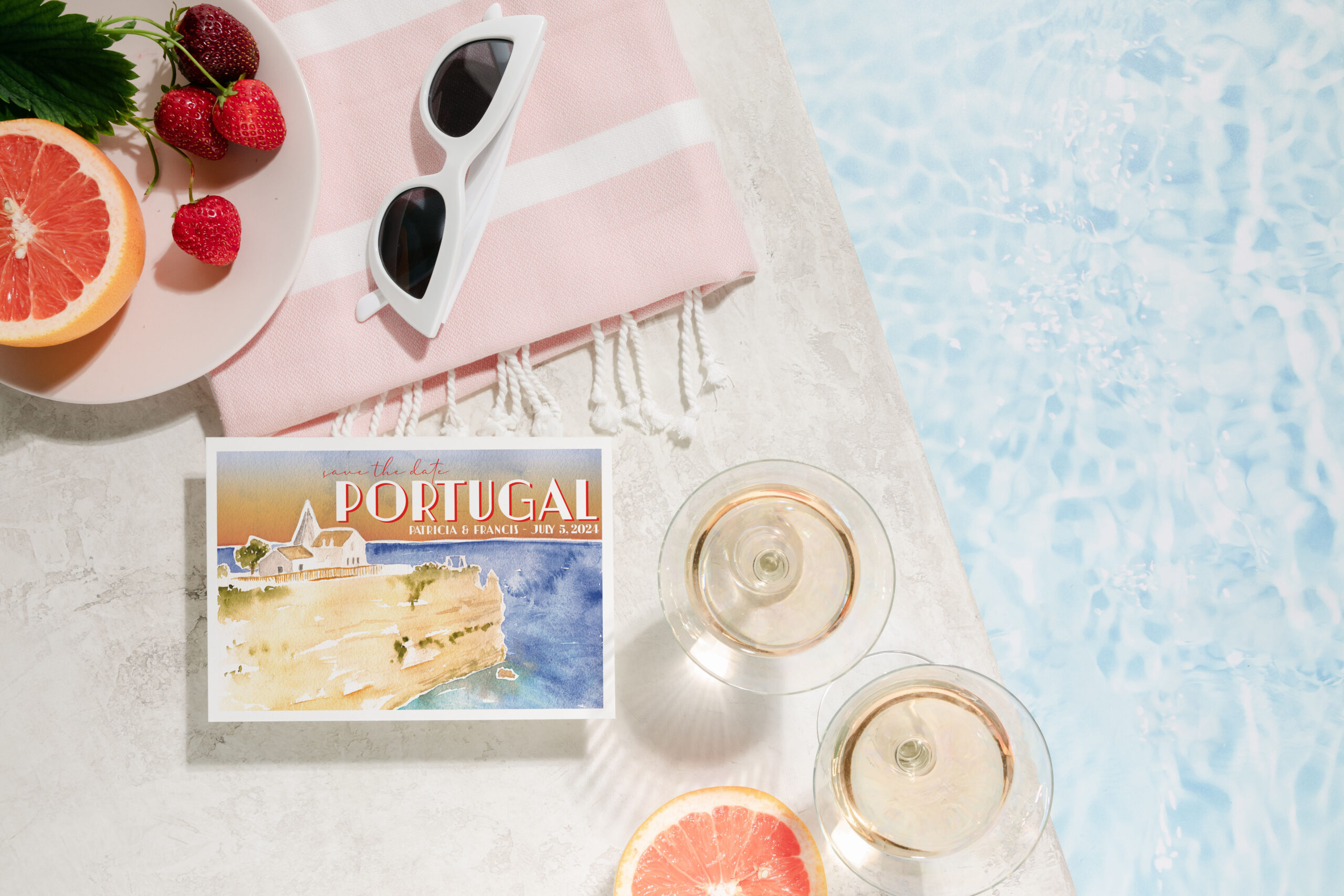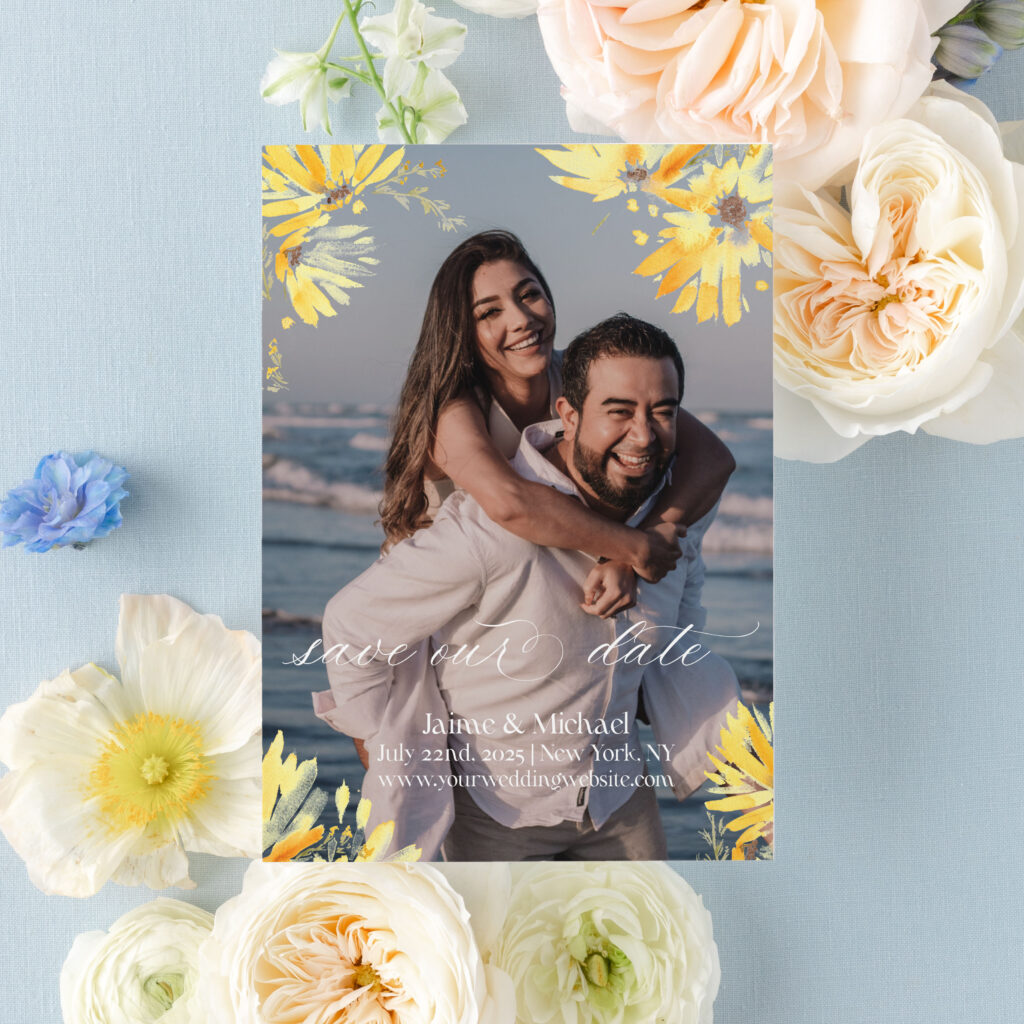What is the Difference Between a Save the Date and A Wedding Invitation?
January 29, 2025
As a luxury stationery designer, I often find myself explaining the intricate world of wedding stationery to my couples. One of the most common questions I receive is about the difference between save the dates and invitations, and whether both are truly necessary. Let me break down everything you need to know about these essential wedding paper pieces – from what the difference is, to what to include on each, and some other commonly asked questions about your wedding invitations.
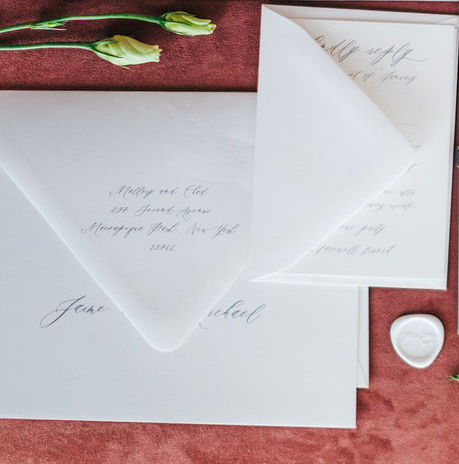
What’s the Difference Between Save the Dates and Wedding Invitations?
It’s not a silly question to wonder what the difference between save the dates and wedding invitations are. Afterall, both are pieces of paper that contain essential information about your wedding. You might be rightfully curious why people send both.
Save the dates and wedding invitations generally serve different purposes in wedding planning. Save the dates are preliminary announcements sent 6-12 months before the wedding to notify guests of the date and location. While invitations are formal requests for attendance sent 2-4 months before, containing all event details and requiring an RSVP.
Save the dates are exactly what they sound like – they’re an announcement to your guests to hold the date on their calendars and not make any other plans. Because they’re sent out earlier, usually as soon as you know the location and have secured the date, it’s too early to have some of the finer details ready to send. For example, the ceremony time might not be confirmed for several more months. So you send out save the dates with enough information that your guests don’t accidentally book over it and work on confirming the rest of the details in the meantime.
What is a Save the Date?
A save the date is a preliminary wedding announcement that asks guests to reserve your wedding date on their calendar. It serves as an informal heads-up that a formal invitation will follow, typically sent 6-12 months before the wedding to allow guests time to plan travel and accommodations.
A save the date is just an announcement. It’s not a formal invitation or a request for an RSVP. As I mentioned above, you might not have enough details to give your guests yet to confirm their RSVP. And your guests might not be ready to commit yet so far in advance.
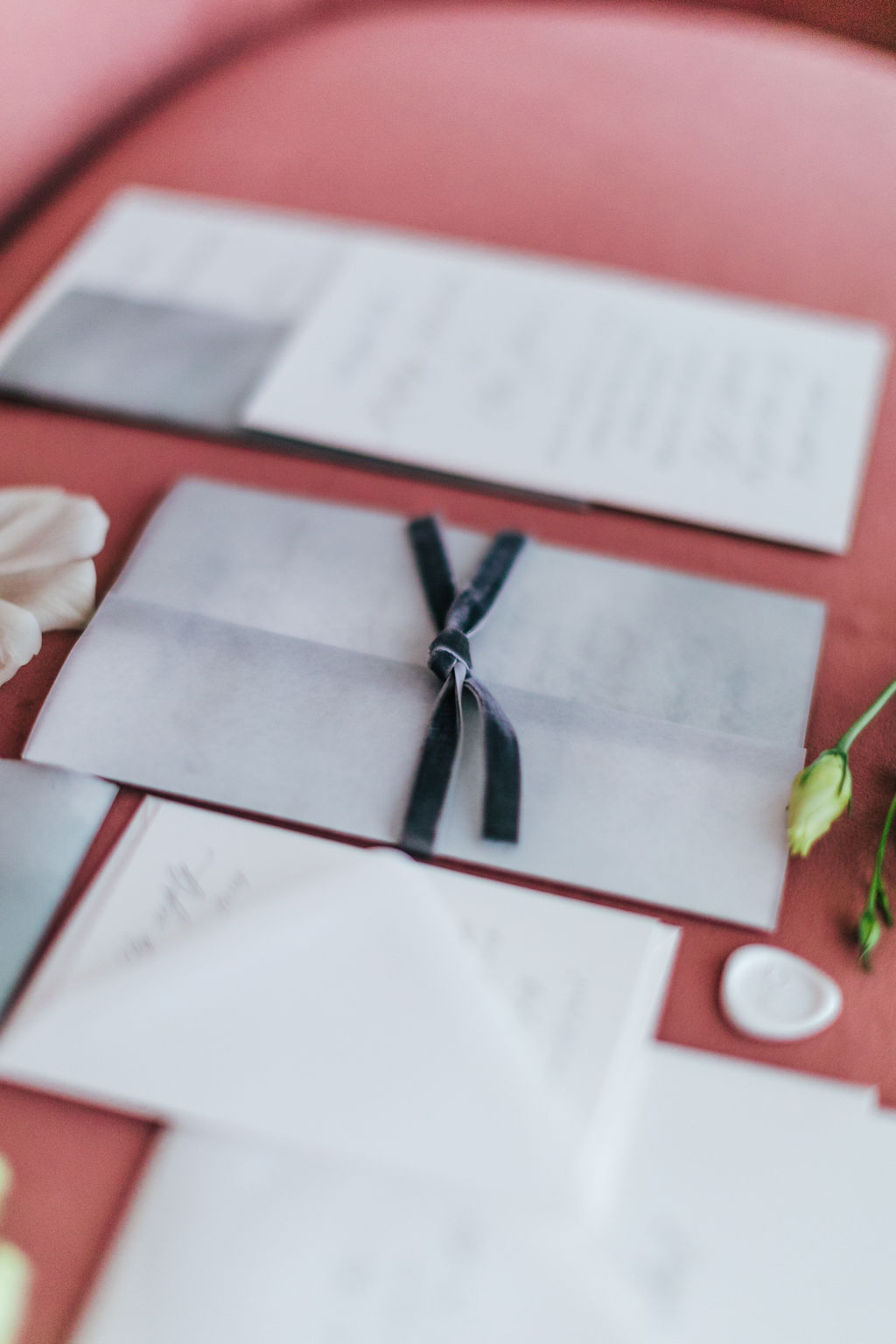
What Information Goes on a Save the Date?
Since save the dates let guests know in advance to hold the date for your wedding, they typically include a few essential pieces of information about your wedding.
Save the dates should include the couple’s names, wedding date, city and state (or country for destination weddings) of the celebration, and a note that formal invitations will follow. Including your wedding website is optional but recommended for providing additional planning information to guests as it becomes available.
You do not need to include the time of the wedding, the exact venue or ceremony location (although you can include your venue name if you wish to), RSVP information, registry information, dress code, or other key details that you might include on a wedding invitation. Usually this is because you won’t know these details yet and will need a few more months to confirm them. But your guests also don’t need this additional information in order to hold the date on their calendars.
What Information Goes on a Wedding Invitation?
Since a wedding invitation is an invitation to respond, more information is needed than the save the date.
Wedding invitations must include the couple’s names, ceremony date and time, venue city and state, reception details, RSVP instructions, and a dress code (if applicable). It also typically includes a host line. Additional cards in the wedding invitation suite may also provide information about accommodations, transportation, and other wedding weekend events.
The wedding invitation itself should stick to the basic information about the wedding ceremony. Traditionally a reception card was used if the ceremony and reception were at different locations. For example, a church wedding ceremony would list the ceremony location on the invitation, but the reception following would be listed on a separate card. It’s much more common these days to have the ceremony and reception within the same venue, making the reception card unnecessary. It’s also more common as a result to list both locations on the invitation now.
Couples have transformed the traditional reception card into more of a details card that includes additional information that doesn’t fit on the invitation. And the RSVP information, even if you’re asking people to RSVP online, goes on a third separate card.
You definitely can simplify the traditional three-card suite into just one invitation card, if you wish to. Leave off any extraneous details and direct guests online to your wedding website for more details and to RSVP instead. You can do this in one line at the bottom of the invitation or in a line on the back of the card.
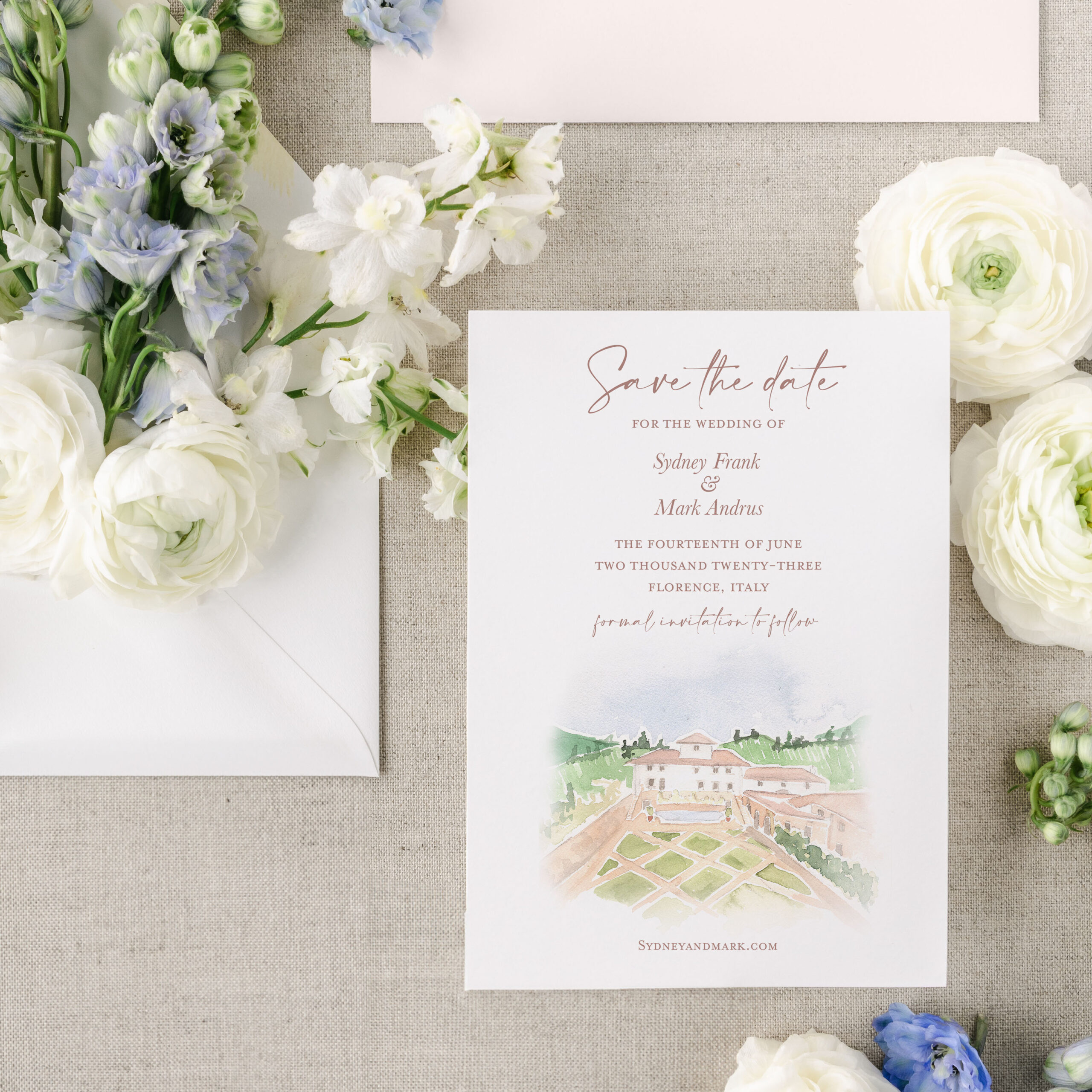
Are Save the Dates Really Necessary?
Now that you know the difference between the two – save the dates and invitations – you might be wondering if you can skip the save the dates altogether. Here’s when a save the date really is necessary.
Save the dates are necessary for destination weddings, out-of-town celebrations, holiday weekend weddings, or any wedding with more than 50% of guests traveling. This is because you’ll probably need to give your guests as much notice as possible to attend. And a save the date can be sent out quickly without confirming the smaller details.
For weddings planned within 6 months, you can skip save the dates and just go straight to sending invitations. Since a save the date would just end up going out back to back with the invitation if you have a shorter timeline.
For my own wedding, I planned it in about 7-8 months and I still had enough time to send save the dates and invitations. Since it was out of town for a lot of guests, I felt it was important to give my friends and family as much notice as possible. It also helped us get a preliminary head count of who might be attending.
When Should You Send Save the Dates?
Send save the dates 6-12 months before a standard wedding and 12+ months before a destination wedding. This timing allows guests to block the date, research travel options, and budget for associated costs before receiving the formal invitation.
Ultimately, it’s never too early to send out a save the date. You can send it as soon as you’ve locked the location and date down.
Can You Mix Digital Save the Dates with Paper Invitations?
It is extremely common for couples today to forgo paper save the dates and send digital ones instead.
Digital save the dates paired with traditional paper invitations is an acceptable and increasingly common approach. This combination maintains formality while being cost-effective and environmentally conscious. However, consider your guest list’s technology comfort level when making this decision.
I find this to be a good compromised if you want to save on paper for budget or sustainability reasons. You can send a digital save the date and then still set the right tone and intention by sending physical invitations.
I shy away from recommending digital invitations for your wedding unless it’s a very casual affair. It sends the message that you are NOT having a formal event and that you’re looking for ways to save money. Guests, whether they mean to or not, will assume you’re scrimping on not just the invitations if you go the digital route. They’ll assume you’ll be looking to save elsewhere that affects guest experience as well. If that’s not an impression you mind giving, that’s totally understandable! My parents had a laid back BBQ for their wedding in the ’80s that was very lovely and a fun time. And while they didn’t send digital invitations back then, it was understood by their guests that it was a casual, celebratory event. The question to ask yourself is not what you SHOULD do because everyone else is doing it but does the invitation match the tone and formality of your event? Or are you giving guests the wrong impression?
How Much Should You Budget for Wedding Stationery?
Speaking of budgeting, here’s a good rule of thumb when considering how your wedding stationery fits into the overall budget:
Wedding stationery typically accounts for 2-4% of your total wedding budget. Save the dates are usually less expensive than invitations, costing between $150-500 for 100 ready-designed pieces (more like $1000-2000 for semi-custom or custom save the dates). While full invitation suites range from $500-2500+ for 100 sets, depending on printing method and level of customization.
What this looks like is if you’re having a $35,000 wedding, you should look to spend $700-1400 on your wedding stationery. That’s a good budget for someplace like Minted, Canva, Zola, or Zazzle where you can pick a design and customize it with your information. A $100k wedding would give you a budget of $2,000-4,000 to work with which is usually enough for semi-custom or custom work from a stationery designer. And if your budget is in the multi-six figures or seven figures, then you can afford luxury paper goods with all of the extra add-ons. Letterpress, foil, embossing, double or triple thick paper, and a whole world of alternative materials and techniques is open to you at those budget levels.
Tips for Creating Cohesive Wedding Stationery
Whether you’re working with a stationery designer, or looking to DIY your own stationery look, here are some tips to make things look professional and create a cohesive wedding stationery collection:
- Choose consistent fonts and design elements across all pieces
- The elements don’t have to be super matchy-matchy, try picking items that are within the same style and color palette
- Select complementary papers and printing methods
- Maintain your color palette throughout
- Use similar language and tone in all communications
While it seems simple, it’s easier than you think to fall in love with one font for your save the dates, then a different one for your invitations, and then not be able to find options for day of with the same fonts throughout. Or to have so many different ideas for themes on your pinterest board that you want to try them all. Some ideas will mesh well together, others will not. So be careful not to create too much of a patchwork approach across your stationery if you want it to look and feel like it’s part of the same event.
What Are Examples of Save the Date Wording?
Save the dates should be clear and concise while matching your wedding’s tone. Popular formats range from traditional announcements to modern and playful phrases that reflect the couple’s personality while conveying essential information.
Traditional Save the Date Examples:
Please save the date
Sarah Elizabeth Bennett
and
William James Thompson
are getting married
Saturday, June 15, 2026
Boston, Massachusetts
Formal invitation to follow
Save the Date
for the wedding of
Emma Lynn & Christopher John
the twelfth of October, two thousand twenty-five
Napa Valley, California
Modern Save the Date Examples:
We’re tying the knot!
Kate & Mike
12.31.2026
New York City
Details coming soon!
Mark your calendars!
Our adventure begins
September 3, 2024
Jessica & Andrew
Maui, Hawaii
jessandandrew.com
What Should Wedding Invitations Say?
Wedding invitations require specific wording that communicates all necessary details while adhering to etiquette guidelines. The formality of your wedding should dictate the tone and format of your invitation text.
Formal Wedding Invitation Example:
Mr. and Mrs. James William Carter
request the honor of your presence
at the marriage of their daughter
Elizabeth Marie
to
Thomas Henry Wilson
Saturday, the twenty-fourth of August
two thousand and twenty-five
half past four o’clock in the afternoon
Saint Patrick’s Cathedral
New York, New York
Reception to follow
The Plaza Hotel
Black-tie
Semi-Formal Wedding Invitation Example:
Together with their families
Caroline Evans
and
Daniel Roberts
invite you to celebrate their marriage
Saturday, August 24, 2024
4:30 in the afternoon
The Garden Terrace
Newport, Rhode Island
Dinner & dancing to follow
You can learn more about wedding invitation etiquette and wording here in this article.
What Are Common Wedding Stationery Mistakes to Avoid?
The most frequent wedding stationery mistakes include ordering incorrect quantities, missing critical information, and poor timing. These errors can lead to unnecessary stress and additional costs during wedding planning.
Top Mistakes to Avoid:
Incorrect Timing
- Sending save the dates too late (less than 6 months before)
- Mailing invitations too early (more than 3 months before) or too late (less than 6 weeks before)
- Not allowing enough time for design and printing (start 2-3 months before sending)
Quantity Errors
- Not ordering extra envelopes for addressing mistakes or getting lost in the mail (order 5-10% extra)
- Forgetting to account for households vs. individual guests (usually about 60% of the guest list)
- Not ordering enough invitations for keepsakes or extra last minute guests
Information Oversights
- Missing RSVP deadlines
- Forgetting to include dress code
- Not providing clear directions or accommodation details
- Leaving off wedding website information
- Typos and mispellings
Design Missteps
- Choosing illegible fonts
- Making text too small
- Using dark ink on dark paper
- Overcrowding the design with too much information
Etiquette Errors
- Including registry information on the invitation
- Addressing envelopes incorrectly
- Not including plus-ones clearly
- Not using the correct host line
These don’t even cover the mistakes you can mail when mailing your invitations. For more detail on mailing mistakes to avoid, check out this article.
Working with a Luxury Stationery Designer
A professional stationery designer can help create a cohesive wedding paper suite that sets the tone for your celebration. We guide you through paper selection, printing methods, and timeline planning while ensuring every detail reflects your wedding style.
Ready to create your perfect wedding stationery suite? Contact us to discuss your vision and how we can bring it to life through beautiful, thoughtfully designed pieces that will become cherished keepsakes of your special day.
Privacy Policy | REFUND POLICY
powered by Showit |
Copyright 2024 |
follow
Cotton & Bow is a stationery company located in Westchester, NY that specializes in watercolor wedding invitations, handmade paper, and other premium illustrated stationery. Contact us for your custom stationery needs or visit the shop for semi-custom and ready-to-ship items.
